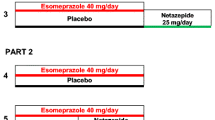Summary
The effect of treatment for 4 weeks with the H2-receptor antagonist ranitidine 200 mg daily on ulcer healing, clinical symptoms and antacid consumption, and on gastric acid secretion, was studied in a double blind trial in 48 patients with a total of 50 endoscopically confirmed duodenal, prepyloric or corporeal gastric ulcers. Patients whose ulcers did not show complete healing within 28 days were continued openly on ranitidine for up to a further 4 weeks. Endoscopy, basal gastric acid secretion (BAO) and pentagastrin-stimulated maximal secretion (PAO) studies were performed at 2-week intervals. After four weeks, 73% of the gastro-duodenal ulcers in the ranitidine group showed complete healing versus 42% in the placebo group (p<0.05). Gastric acid secretion was considerably inhibited both under basal (89%; p<0.001) and maximal challenge (71%; p<0.001) conditions. The inhibitory effect was still pronounced 13–15 h after administration of ranitidine 100 mg. Symptoms and the need for antacids were significantly reduced. Ranitidine appears to be an efficacious, safe and well tolerated medicine principle for the treatment of gastro-duodenal ulcer disease.
Similar content being viewed by others
References
Achord JL (1981) Gastric pepsin and acid secretion in patients with acute and healed duodenal ulcer. Gastroenterol 81: 15–18
Ash AS, Schild HO (1966) Receptors mediating some actions of histamine. Br J Pharmacol 27: 427–439
Berstad A, Kett K, Aadland E, Carlsen E, Frislid K, Saxhaug K, Kruse-Jensen A (1980) Treatment of duodenal ulcer with ranitidine, a new histamine H2-receptor antagonist. Scand J Gastroenterol 15: 637–639
Domschke S, Lux G, Domschke W (1980) Effect of ranitidine on pentagastrin induced gastric secretion of pepsin and N-acetylneuramic acid (NANA) in man. Gastroenterol 78 [5]: 1158
Forssell H, Koch G (1983) Gastroduodenal ulcer healing evaluated by repetitive endoscopic determination of ulcer size in patients on ranitidine or placebo. Curr Ther Res 33: 459–465
Henry DA, Mac Donald IA, Kitchingham G, Bell GD, Langman MJS (1980) Cimetidine and ranitidine: Comparison of effects on hepatic drug metabolism. Br Med J 2: 775–777
Johnson DH (1965) Gastric ulcer: Classification, blood group characteristics, secretion patterns and pathogenesis. Ann Surg 162: 396–404
Kett K, Aadland E, Berstad A (1980) Inhibition of gastric secretion in man with a new H2-receptor antagonist, ranitidine. Scand J Gastroenterol 15: 249–251
Langman MJS, Henry DA, Bell GD, Burnham WR, Ogilvy A (1980) Cimetidine and ranitidine in duodenal ulcer. Br Med J 2: 473–474
Mantel N (1963) Chi-square test with one degree of freedom, extensions of the Mantel-Haenzel procedure. Am Stat Assoc 58: 690–700
Nelis GF, Van de Meene JGC (1975) Comparative effect of cimetidine and ranitidine on prolactin secretion. Postgrad Med J 56: 478
Odén A, Wedell H (1975) Arguments for Fisher's permutation test. Ann Stat 3: 518–520
Peden NR, Boyd EJS, Saunders JHB, Wormsley KG (1981) Ranitidine in the treatment of duodenal ulceration. Scand J Gastroenterol 16: 325–329
Scheurer U, Witzel L, Halter F, Keller HM, Huber R, Galeazzi R (1977) Gastric and duodenal ulcer healing under placebo treatment. Gastroenterol 72: 838–841
Staiger C, Simon B, Walker E, Kather H (1980) Influence of ranitidine on antipyrine pharmacokinetics in healthy volunteers. Dig Dis Sci 25: 894
Walt RP, LaBrooy SJ, Avgerinos A, Oehr T, Riley A, Misiewicz JJ (1981) Investigations of the penetration of ranitidine into the cerebrospinal fluid and comparison of the effects of ranitidine and cimetidine on male sex hormones. Scand J Gastroenterol 16 [Suppl 69]: 19–23
Author information
Authors and Affiliations
Rights and permissions
About this article
Cite this article
Forssell, H., Koch, G. Effect of H2-receptor blockade by ranitidine on ulcer healing and gastric acid secretion in patients with gastric and duodenal ulcers. Eur J Clin Pharmacol 25, 195–198 (1983). https://doi.org/10.1007/BF00543790
Received:
Revised:
Accepted:
Issue Date:
DOI: https://doi.org/10.1007/BF00543790




